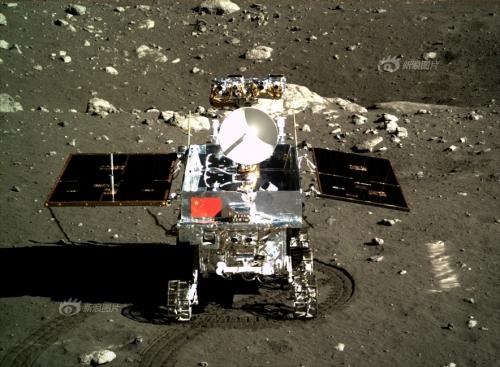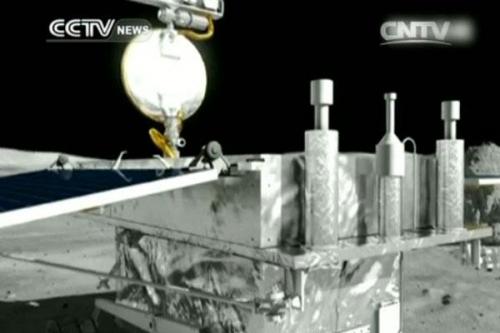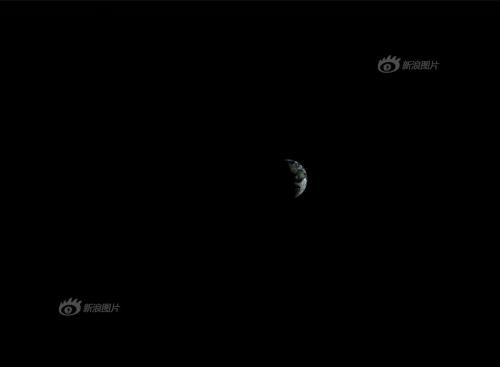China's history making moon robots – the Chang'e-3 lander and Yutu rover – have just awoken from the forced slumber of survival during their first, long frigid lunar night and have now resumed full operations – marking a major milestone in the mission.
This landmark achievement offers a realistic prognosis that the best is yet to come for this new dynamic duo of robots dispatched from Earth.
The stationary lander and six wheeled rover were autonomously revived from their dormant mode this weekend.
Both were then placed back into full working science mode in response to commands issued by Chinese space engineers at the Beijing Aerospace Control Center (BACC), according to CCTV, China's official government broadcast network. Yutu woke up first on Saturday, Jan. 11, at 5:09 a.m. Beijing local time.
The Chang'e-3 lander was awoken on Sunday, Jan. 12, at 8:21 a.m. Beijing local time, according to a BACC statement.
Both vehicles depend on their life giving solar panels to produce power in order to function and accomplish their scientific tasks.
They went to sleep to conserve energy since there is no sunlight to generate power with the solar arrays during the lunar night.
During the nocturnal hiatus they were kept alive by a radioisotopic heat source that kept their delicate computer and electronics subsystems warmed inside a box below the deck. It was maintained at a temperature of about minus 40 degrees Celsius to prevent debilitating damage.
The simple fact that both spacecraft survived half a month through the extremely harsh lunar night time environment when temperatures plunged to below minus 180 degrees Celsius, or minus 292 degrees Fahrenheit, and then restarted intact, proves the resiliency and robustness of China's space technology.
"During the lunar night, the lander and the rover were in a power-off condition and the communication with Earth was also cut off," said Zhou Jianliang, chief engineer of the BACC, to CCTV.

Portrait photo of Yutu moon rover taken by camera on the Chang’e-3 moon lander on Dec. 15, 2013 shortly after rolling all 6 wheels onto lunar surface. Credit: Chinese Academy of Sciences
"When the night ends, they will be started up with the power provided by sunlight and resume operation and communication according to preset programs," Zhou said.
As night fell on the Earth's Moon at Christmas time 2013, Yutu and the mother ship lander both entered a state of hibernation – determined to survive the utterly harsh lunar darkness upon the magnificently desolate gray plains.
The mother ship began her nap first on Christmas Day, Dec. 25. Yutu went to sleep on Dec. 26 obeying commands sent by mission control at BACC, according to China's State Administration of Science, Technology and Industry for National Defence (SASTIND).
Just prior to hibernating, the lander snapped the first image of the Earth taken from the Moon's surface in some four decades.
Now with the dawn of daylight the solar panels were unfurled and the instruments activated on both robots.
Yutu has already resumed roving towards pristine, unexplored lunar terrain surrounding the touchdown zone at Mare Imbrium, nearby the Bay of Rainbows, or Sinus Iridum region.
After driving in a semicircular path around the right side of the stationary lander, and snapping portraits of one another at 5 preselected locations, Yutu parked some 40 meters south of the mother ship – after touchdown and prior to the start of lunar night.
Yutu, which translates as 'Jade Rabbit', is departing the landing zone forever, trekking southwards for surface investigations expected to last at least 3 months – and perhaps longer depending on its robustness in the unforgiving space environment.

The “Yutu” rover and the Chang’e-3 lander began functioning again on Jan 11 & 12, 2014 in this artists concept. Both had become dormant to ride out the harsh conditions on the moon. Credit: CNSA/CCTV
The Chang'e-3 lander should survive at least a year.
"They will begin to conduct scientific explorations of the geography and geomorphology of the landing spot and nearby areas, and materials like minerals and elements there," noted Wu Weiren, chief designer of China Lunar Probe Program.
"We will also explore areas 30 meters and 100 meters beneath the lunar soil. The exploration will continue longer than we planned, because all the instruments and equipments are working very well."
The robotic pair safely soft landed on the Moon on Dec. 14 at Mare Imbrium, located in the upper left portion of the moon as seen from Earth. Seven hour later on Dec. 15, Yutu rolled all 6 wheels onto the moon's surface, leaving tracks behind as it cut into the loose regolith.

Lander camera snapped this image on Christmas Day 2013. Credit: Chinese Academy of Sciences
Presumably they will continue exploring for about the next 14 days – the entire time span of their 2nd Lunar Day, unless they need to take a break from the high daylight temperatures.
Thereafter Yutu and Chang'e-3 will function in alternating cycles of 2 weeks on and 2 weeks off for the duration of their independent working lifetimes.
China is only the 3rd country in the world to successfully soft land a spacecraft on Earth's nearest neighbor after the United States and the Soviet Union.





